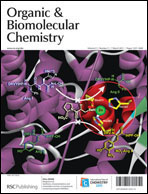Exploring the biocatalytic scope of a bacterial flavin-containing monooxygenase†
Abstract
A bacterial flavin-containing monooxygenase (FMO), fused to phosphite dehydrogenase, has been used to explore its biocatalytic potential. The bifunctional biocatalyst could be expressed in high amounts in Escherichia coli and was able to oxidize


 Please wait while we load your content...
Please wait while we load your content...